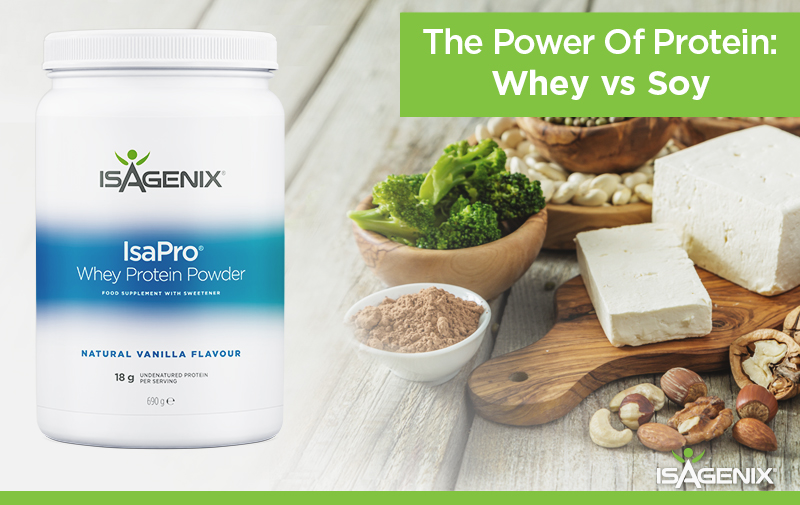The Power of Protein: Soy vs Whey
August 16, 2017,
isagenix

Protein is essential for the growth and repair of muscles, and is an essential part of every cell in the body.
There are 20 different amino acids that make up proteins, and it is the sequence of these amino acids that characterises the role of the protein. Of the 20 amino acids, eight are considered ‘essential’ as they are not able to be made by the body, so we need to get these from the diet. Animal protein sources provide all eight essential amino acids. With so many different types of protein available, it can be difficult to understand which is most beneficial.
What is whey protein?
Whey is one of two major types of protein found in milk, the other being casein. Whey is concentrated after milk is filtered to remove the majority of the fat and carbohydrate.
What is soy protein?
Soy protein is a vegetable protein sourced from the soybean. It’s a ‘complete’ protein meaning it provides all the essential amino acids.
What do the studies say?
Research carried out in Switzerland has shown support for the consumption of whey protein over other proteins, including those from soy (1).
This study was a double-blind, placebo-controlled, randomised trial in which volunteers were fed three protein test meals on separate occasions, providing 20% of the individual’s daily energy requirements.
The protein test meals consisted of 50% energy from protein, 40% from carbohydrate and 10% from fat. Each of the three meals used a different protein source; whey protein isolate, micellar casein, or soy protein. The volunteers were also fed a fourth meal which consisted almost entirely of carbohydrate.
Protein-rich meals are well known to have a greater thermic effect than carbohydrate-rich meals, meaning more energy is required to digest, absorb and metabolise the protein-rich meals. The study’s results showed that the thermic response is greater following the consumption of whey protein than other proteins, while subjective appetite analysis found that casein and soy offered greater satiety and that whey was more “liked” in comparison.
Consuming foods with a higher thermic effect means more energy is required to digest, absorb and metabolise these foods, and eating these foods with a higher thermic effect can lead to greater fat oxidation (2).
The consumption of animal proteins, such as whey, have shown to lead to greater increases in protein synthesis when compared to vegetable proteins, stimulating growth of muscles (3). The increase in protein synthesis could be responsible for the increased thermic response that was observed after high-protein meals, compared to high-carbohydrate meals.
Within the study, the researchers went on to explain that the higher thermic effect of whey protein may be due to the amino acid composition. Whey protein is higher in leucine than plant-based proteins. Leucine is a branched-chain amino acid, which has been shown to stimulate muscle protein synthesis (3, 4).
So what is the verdict?
This study compared different types of protein which suggested they whey protein is the preferred choice for weight loss and muscle growth.
That’s why Isagenix uses undenatured whey protein in our products; to ensure we are giving our Customers the best tools to help them achieve their goals; whether they be for weight management or energy and performance! Find out more about our science-backed products here.
References
- Acheson KJ. Protein choices targeting thermogenesis and metabolism. Am J Clin Nutr 2011; 93:525-34.
- Skidmore P. Macronutrient intake and their role in obesity Nutr Bull 2007;32(suppl 1):4-13.
- Tang JE, Moore DR, Kujbida GW, Tarnopolsky MA and Phillips SM. Ingestion of whey hydrolysate, casein, or soy protein isolate: effects on mixed muscle protein synthesis at rest and following resistance exercise in young men. J Appl Physiol 2009; 107: 987-992.
- Egan B. Protein intake for athletes and active adults: Current concepts and controversies. Nutr Bull 2016;41:202-213.




